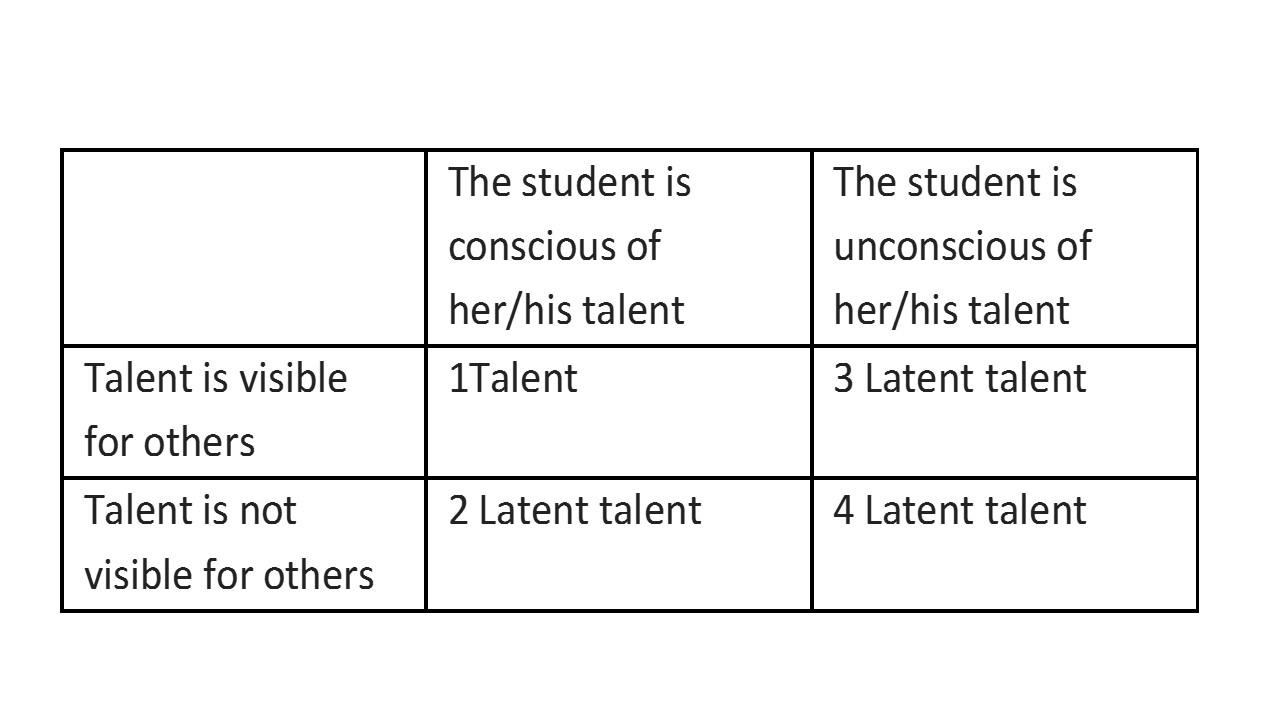Pierre van Eijl and Albert Pilot (eijl0000@wxs.nl, Utrecht University, The Netherlands) Article by page ‘Talent development of students’ on this website
Should we select students for talent trajectories? What are the advantages and disadvantages? And how do we select effectively? An example of selection for admission to an honours programme has been worked out. This refers to step 3 (crossing the threshold: choosing and be chosen) of the ‘Circle of Talent Development’ (Eijl & Pilot, 2016). Expected advantages of selection for honours programmes are to arrive at a group students that are motivated for this programme, can handle the challenges of it so they can develop their talents extra and are able to function as a learning community. The following three sections of this article highlight different aspects of this type of selection such as finding a match, discovering latent talent and self-selection.
1 Finding a match between a student and an honours programme
In admitting students to honours programmes, educational institutions consider in the first place their motivation, in other words, whether the students are interested in the honours programme where they are applying for. The general characteristic of students in honours programmes is that honours students want and can do more than the regular programme offers them. In addition, study progress and marks play an important role in selection. The student's marks should usually be above average, so that additional capacity can be expected from the student. In practice often some students are allowed who didn’t match the required grade point average. They are often doing quite well.
An example of a student’s comment about this process comes from Van Eijl & Pilot, 2016:
"First, I was selected because in my first year I passed my exams with an average of more than 7.0 . If I was interested, I had to send an email and to indicate my interest. Then I received a form about my motivation that I had to send with my Europass CV and an overview of my academic performance. I was then invited for an admission interview. Selection criteria included the match between the wishes of students, the design of the programme and the distribution of participants from different bachelor programmes."
Reva Jenkins-Friedman (1986) an American researcher in the domain of talented students, emphasizes that in a procedure for admission to an honours programme it is necessary to think about
- What are the goals of the selection?
- What are the main objectives, content and design of the honours programme?
- What characteristics of honours students match with this programme?
The answers to these questions can result in different criteria for each honours programme. Point of entry is to find a match between a student and the honours programme (see figure 1).

Figure 1: Finding a match between a student and an honours programme
In an interview with an experienced American site visitor of honours programmes, she emphasized that “Selection relies not only on quantitative data but just qualitative data are important. To have an eye for the individual starts by the selection.” (In: Van Eijl, Pilot & Wolfensberger, 2010 p. 52)
Often a pro-active attitude and ‘passion’ are expected by the students. They not only receive education but they also have to contribute to the organization of activities in the programme by being prepared for meetings, take initiatives to provide new input for the programme or contribute to the further development of the programme.
Sometimes during selection interviews, the institution considers whether the student has to 'walk on his toes' to achieve higher marks and has reached the peak of his ability, or whether he has time for other activities. In the latter case, enrolling in an honours programme is an obvious choice.
2 Discovering and involving latent talent in an honours programme
Some students however don’t make it to the selection. Many students are not at all clear about whether they wish to do an honours programme. They are not aware of their talents, have an attitude ‘I’m just not good enough’ or are afraid being rejected. Or they may well have the capacity to do so, but do not immediately see the benefit of an honours programme. Some of these students may have enough talent to join the honours programme but are not aware of their capabilities: they may have a latent talent.
Verbiest and Dijk (2010) make a distinction, in addition to talent (1), between three types of latent talent (2) –(4) (see figure 1).
- The student is conscious of his/her talent and so are others;
- The student is aware of his/her talent, but his environment has never observed it;
- Talents which someone's environment attributes to him/her, but which he/she has not (yet) discovered;
- Talents which someone and his environment have not (yet) discovered.

Figure 2 Talent and latent talent (Verbiest & Dijk, 2010)
As a result recruiting these students is not always that easy in practice because often they do not see their talents ('latent talent'). A pre-honours programme may offer a solution for hesitant students, which would also enable them to get used to the goals and method of teaching in the honours programme (Coppoolse, Van Eijl & Pilot, 2013, p. 35). Then they can make a better decision about choosing for the honours programme or not. Also the opportunity to enter the honours programme at a later point in their studies may be useful, especially for 'late-bloomers'.
3 Self-selection
Selection doesn’t only take place in an interview with a student. On forehand students think over the possibility of an honours programme or other trajectories for talent development and decide to go for it or not. If institutions offer a pre-honours programme students can acquaint themselves with tackling honours challenges and working with other pre-honours students. If they are successful in the pre-honours programme and like it, they can decide at the end to join the honours programme. It may be for them the choice between ‘the same old way’ or ‘something new’ (see figure 3).

Figure 3: Choice between the ‘same old way’ or ‘something new’
Self-selection is also important in step 1 (identify your drive) and step 2 (choosing a trajectory of talent development) in the circle of talent development. Also in step 4 and further steps a student can come to the conclusion that continuation of the honours programme is not suited. Then we called it drop-out but it may be for the student an extended period of self-selection.
4. Some effects of selection
Retention rates in honours programmes are different, dependent of the specific honours programme, but varies usually between 50 – 100%. In a few cases honours programmes without selection have a higher drop-out rate in the first year, because some students are just trying it out. Also a few students are only aiming to join for one period (a year or semester) an honours programme.
Another effect of selection is that honours students see this as a positive sign: both teachers and students choose for each other and they feel recognized in their potential qualities. Some students that don’t make it to the honours programme however, may be disappointed and feel not valued in their potential talents. Advice for other options may be appropriate for them. Talented students from minority groups can have a disadvantage because they are sometimes less fluent in the language spoken in the honours programme. Other talented students may be not interested in the honours programme because they have other priorities.
Altogether: selection give focus to the admission of an honours programme, but may exclude creative and entrepreneurial students if there is too much emphasis on test scores. Selection requires care but don’t give certainty. How the selection works out had to be monitored later on, if it becomes clear what the experiences are of the honours students. Evaluation of the experiences of students that didn’t make it to the honours programme, may be also interesting.
5 References
Coppoolse, R., Eijl, P.J. van, Pilot, A. (2013). Hoogvliegers, ontwikkeling van professionele excellentie. [Translation: Highflyers, Development towards Professional Excellence] Rotterdam: Rotterdam University Press, Synopsis in English at: https://www.researchgate.net/publication/305215310_Highflyers_development_towards_professional_excellence . Complete Dutch version: http://hr.surfsharekit.nl:8080/get/smpid:60567/DS3/
Van Eijl, P.J., Pilot, A. & Wolfensberger, M.V.C. (2010). Talent voor morgen. (Translation: Talent for Tomorrow] Hoger Onderwijs Reeks. Groningen: Noordhoff Uitgevers.
Eijl, P.J. van & Pilot, A. (2016). The honours Experience, talentontwikkeling door de ogen van de honoursstudent. [Translation: The honours experience: talent development through the eyes of the honours student] Rotterdam: Hogeschool Rotterdam Uitgeverij. Synopsis in English at: https://www.researchgate.net/profile/Pj_Eijl/contributions
Complete Dutch version: http://hr.surfsharekit.nl:8080/get/smpid:61232/DS1
Jenkins-Friedman, R.C. (1986). Identifying honors students. New directions for teaching and learning, 25, 99-108.
Verbiest, C. & Dijk, M. (2010). Oog voor talent. [Translation: Eye for talent] Amersfoort: CPS. http://www.cps.nl/publicaties-uitgeverij/1401/alle-boeken/2407/oog-voor-talent
Zohar, D. (2000). SQ: Connecting with Our Spiritual Intelligence. London: Bloomsbury.
